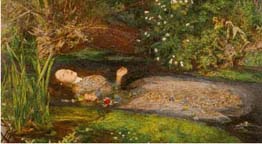[Note 3, Chapter two, in print version] Richard Westall's The Death of Ophelia (1793), which is now in the British Museum, is one of the Earliest Romantic versions of this popular subject (illus. in Marcel Brion, Romantic Art (London, 1960), facing p. 49). According to the Art-Journal, 11 (1849), p. 89, H. Le Jeune exhibited an Ophelia at the 1849 British Institution: "She is presented in a stooping pose, hanging wreaths upon the boughs within her reach." The Ophelia theme takes two basic forms. The first, which is exemplified by these two last-mentioned works, represents the girl standing or sitting beside the water about to take her life, as in Arthur Hughes's two versions (1852, City Art Gallery, Manchester illus. in Raymond Watkinson, Pre-Raphaelite Art and Design (London, 1970), pl. 84; and 1865, Toledo Museum of Art illus. in Rowland and Betty Elzea, The Pre-Raphaelite Era, 1848-1914 (Wilmington, 1976), nos 3-9); Ophelia by A. Ercole (1859, location unknown — see Art Journal, 21 (1859), p. 167); the statue by W. C. Marshall, R. A. (1863, location unknown — illus. in Illustrated London News (28 March 1885), p. 328); and Richard Redgrave's version (1842, Victorian and Albert Museum); see also 1858 version whose is location unknown — illus. in Art-Journal, 20 (1858), pp. 35-45). This form of the Ophelia theme is obviously related to other representations of a mournful young woman by a pool of water, such as Francis Danby's Disappointed Love (1821, Victoria and Albert Museum - illus. in Eric Adams, Francis Danby: Varieties of Poetic Landscape (New Haven and London, 1973), pl. 1) and Viktor Mikhailovitch Vaznetsov's Alionushka (1881, Tretyakov Gallery, Moscow — illus. Aleska Celebonovic Some Call it Kitsch: Masterpieces of Bourgeois Realism (New York, 1975), p. 94).
 Millais's famous painting, which portrays Ophelia floating in the pool that will soon drown her, exemplifies the second major form of this theme. Trapp, The Attainment of Delacroix, pp. 168-9, reproduces the Louvre Ophelia's Death by Delacroix (1853), comparing it both to the painting by Millais and to Paul Delaroche's The Young Martyr (c. 1853, Louvre). George Clairin also painted an Ophelie aux Chardons (c. 1898,
Barry Friedman coll. — illus. in Elzea, op. cit., no. 8-17).
Millais's famous painting, which portrays Ophelia floating in the pool that will soon drown her, exemplifies the second major form of this theme. Trapp, The Attainment of Delacroix, pp. 168-9, reproduces the Louvre Ophelia's Death by Delacroix (1853), comparing it both to the painting by Millais and to Paul Delaroche's The Young Martyr (c. 1853, Louvre). George Clairin also painted an Ophelie aux Chardons (c. 1898,
Barry Friedman coll. — illus. in Elzea, op. cit., no. 8-17).
The dying Ophelia is closely related to another extremely popular subject the dying Lady of Shalott which also shares the horizontal arrangement of the figure. John William Waterhouse's The Lady of Shalott (1888, Tate Gallery) is thus unusual in depicting the Lady in a seated position; more usual are the identically entitled paintings by William A. Breakspeare (n.d., formerly in the Handley-Read coll); John LaFarge (n.d., New Britain Museum of American Art, New Britain, Connecticut — illus. in Elzea, op. cit., nos 337); and John Atkinson Grimshaw (1878, The Pre-Raphaelite Trust — illus. in ibid., no. 4-36)
Last modified 16 July 2007
